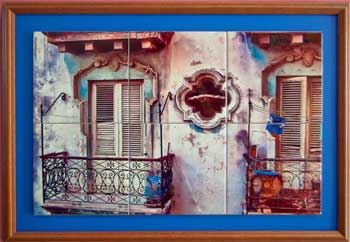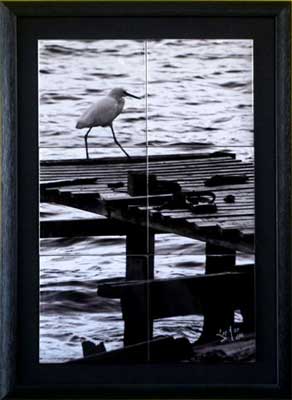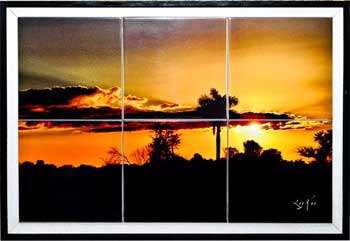Cuba’s “LezKno” Photographing Dreams
Helson Hernandez

HAVANA TIMES — Yasser Lezcano is a point of reference in the visual arts in Cuba. He told HT: “I never saw art as a way of life, nor did I dream that I would make a living from it.”
HT: How long have you devoted yourself to the visual arts?
LezKno: For almost ten years, ever since I started leaning towards art in general and photography in particular. At first I approached it very empirically and through self-instruction, since I don’t have any academic artistic training.
Later I became more serious about it, trying to make up the “lost” time, or rather the time spent on other activities in which artistic creation seemed only like a dream. If we speak of my time spent in the visual arts, I can tell you that what matters to me isn’t only the time that has passed, but what lies ahead – my goals, dreams and projects. Clearly, the past is experience that also counts.
HT: Your training is also related to the art to which you are one of the most faithful exponents today, or is there another story before you reached the stage of the LezKno that we presently know.
LezKno: Perhaps my story is similar to those of many other Cubans, but in my case I didn’t change professions in search of more money. I never saw art as a way of life, nor did I dream that I would make a living from it.
As a child I loved the visual arts, mainly painting, but because of things in life I decided that I wanted to be a lawyer. That was a time when we all dreamed of being doctors or lawyers. It was also the dream of our fathers – seeing their children graduate from the university. And that’s what happened; I graduated in law in 1994. I loved my job and I don’t think that I was too bad at what I did.
Still, in my free time I always did things that I taught myself. There came the moment in which my work as an artist began to clash with my professional life. I created some works that began to catch the attention of critics and the media, so I had to decide whether to follow my profession or take that leap into the void into a strange, new and unknown world.

This was where I believed there was great art that I could experience, but at the risk of everything. So that’s what I did… I went home, created my little studio in my mother’s house and lived for the sake of art. The first years were hard, mainly because of internal conflicts between my work and what I wanted to do, and of course, also for economic reasons.
HT: Have you always worked with photography within the specialties of visual arts?
LezKno: Photography is the starting point of everything I do, but my first works were murals of Byzantine mosaics. I learned a lot from that, though of course I studied as well – and I still do.
My first oversized work was the “Capitolio de la Habana” – a mosaic mural measuring 2.75 x 2.75 meters and having 6,232 pieces. It took me almost two months and now it’s on a wall in my house. It’s dedicated to my wife Leticia. That work was the final element in my decision to devote myself to art.
HT: What do you find in photography as a means of expression, given that you became interested in it when taking into account the amplitude of the visual arts?
LezKno: I always wanted to be a painter, but why a photographer? Inexplicably, I think that genetics is very important. My grandfather Fernando Lezcano Miranda was a photojournalist and an artist who was very prominent in the 1930s. He was the one who took the picture of the assassination of the martyred student Rafael Trejo, on September 30, 1930.
That story was told to me by my uncle Fernando Lezcano, who was also a photographer. He worked with my grandfather and was his student. Through his stories I fell in love with photography and started wanting to be like them. I’m very proud that part of my family is included in the history of Cuban photography as great exponents of this art.
When I see things around me but I don’t have my camera, I imagine the shot, how it would look, and that’s how I spend my days creating things. I don’t think I’ll have enough time in my life to do everything I’ve thought about. Photography as a means of expression can mean many things, perhaps more clearly than through other art forms since you’re reflecting reality. I’m not one of those artists who seek complicated ??or conceptual expressive languages. There are lots of ways to convey what you want.
HT: Among the exhibitions of your work so far, which do you consider as having been your most important creative stage and, simultaneously, the most satisfying for you?

LezKno: I’m never 100 percent satisfied with my work. I think I’ve matured as a photographer over the years and that my artwork is still being developed. I always say that I’m a recent graduate trying to find a space. I’m full of ideas, projects and aspirations. If my work gains relevance at some point, that will be up to time and the people who come to appreciate my work. Sincerely, I think I’m almost at the beginning of my career.
HT: If you were to define yourself in your creative world, what words would you use to for the concept you pursue as a photographer and a creator of visual art in Cuba?
LezKno: Different. Not the same.
HT: You’ve developed a very unique approach in the visual context of the island. Tell us about “Foto Ceramic.”
LezKno: I felt the need to do something different and that would identify my work, a stamp of my creative production. I began to experiment with the printing of my images on ceramics, managing to “Cubanize” the process, so to speak.
The technique is well developed around the world, but due to lack of resources in our country and the special raw materials needed, it turned out to be almost impossible here. So, I engaged myself in this adventure. It’s been a long three years of hard work and suffering, anguish, internal emotional conflicts, frustrations and many bad things that now I can’t explain.
But in the end, those who persevere succeed. When I saw my first impressions on ceramics I was very happy – very happy. Since then everything has changed. My work has taken a different course. We’re talking about over 300 murals in different formats. Some pieces are exhibited in Cuba and others in other countries.
It’s important that people know that I work to create unique pieces despite these being photography. The image that I put on the murals it not repeated again and it becomes registered with the National Copyright Center. I have a workshop and permanent exhibition space located at 1710 42nd Street, between 17th and 19th streets in the Playa neighborhood. People can come here to view my work.
HT: Tell us about the service you offer to those interested in imprinting their image on one of your individual creations.
LezKno: This is something that arose from the need to promote our exhibition space, but it also has a commercial character. The original idea was created to promote my work on ceramic tiles and pottery. But then I found it interesting that people could put their pictures on tiles or mugs, so I began providing that service, though I always explain to them that our role is to create art, and that we’re not a printing business.
We don’t reproduce the work of other artists, which has led to a lot of misunderstanding – mainly by artists looking to print their work in different medium. I try to explain that if I spend all my time and effort printing the works of other people, I’ll have very little time to create, which is ultimately what I want to continue doing.
Our gallery is open daily from 9:00 a.m. to 6:00 p.m., and Sundays until 2:00 pm. People can come there to access our work and order a custom-made gift on tiles or mugs. In the future these will be plates as well.

HT: What can you tell us about working with children in your community workshops?
LezKno: It’s something very interesting and cute. This project is carried out directly by my wife, Leticia, who is my assistant and muse. Every Saturday in our gallery we give free classes to children from the ages of 8 to 15. The first stage of the workshops is in photography and papier-mâché, culminating with an exhibition of the children’s work entitled “Fotografiando sueños” (Photographing Dreams). Children are like sponges. You have to see the things they say and do. They themselves are a dream.
Right now we’re teaching mosaic techniques with the idea joining in with other artists in the community to contribute a little to the next generation.
HT: Do you have any special project in the works for this year?
LezKno: I plan to work long and hard. I’m preparing my first individual exhibition of ceramic photos outside of my gallery. This exhibit will be in Old Havana in July. As for other plans, I don’t want to preview them too far in advance.





